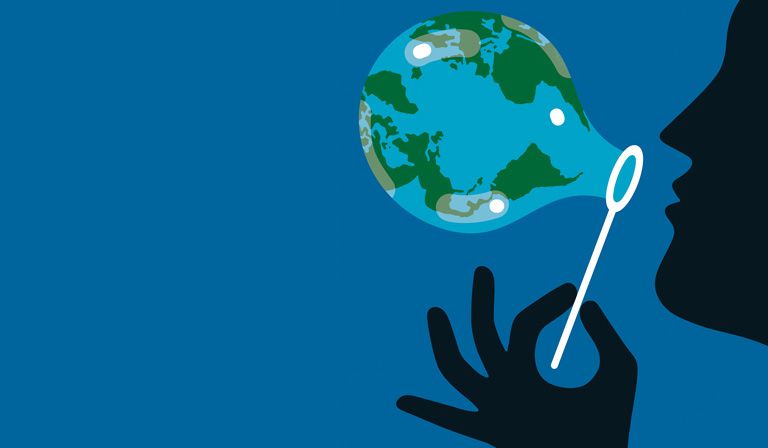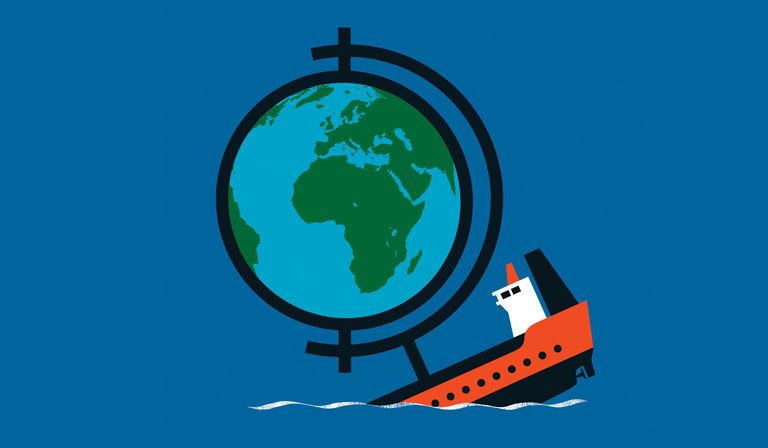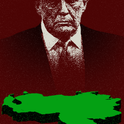The death of globalisation has been declared more often than you can count. Yet despite myriad tensions and challenges, the global system of production, trade and finance endures. Globalisation survived the Global Financial Crisis. It survived Brexit and four years of Donald Trump’s presidency. And it survived Covid-19, confounding predictions that the virus would spell an end to global supply chains.
It is tempting to conclude that globalisation is simply too deeply embedded in modern society to be reversed. Corporations such as Apple, which designs its products in California but manufactures in Asia, derive enormous benefit from the ability to hire talent, source inputs and conduct assembly operations in multiple countries around the world. What is true of large corporations and manufacturers is increasingly true of small companies and services as well. The Wall Street Journal wrote recently of Scottevest, a travel clothing firm that once employed 20 office workers at its headquarters in Ketchum, Idaho but now instead uses graphic designers in Ukraine, customer service agents in Albania and an order processor in India, all made possible by the internet’s global reach.
Brexit may prevent British farmers from employing eastern European labour, but if they want reliable fruit-pickers they still need foreign workers, some now imported from as far away as South Africa and Indonesia. Covid-related shipping container shortages and port shutdowns may have interrupted supplies of foreign goods, but this only confirmed how much consumers depend on imported merchandise in the course of daily life. Large corporations, small companies, fruit farmers and consumers understand that globalisation is an indispensable aspect of our 21st-century world. They can be expected to protest forcefully—and effectively—against attempts to turn back the clock.
At least, that’s the theory. In reality, this Panglossian narrative is too simple. For current threats to globalisation are more serious than their predecessors. They are of a different sort than past threats successfully rebuffed.
With the benefit of hindsight, we can see that the heyday of late 20th- and early 21st-century globalisation was the two-decade period ending with the onset of the Global Financial Crisis in 2008. Over those 20-odd years, global exports and imports rose even faster than global GDP, driven by the fast growth of China and its integration—along with other emerging markets—into the global trading and financial system. An increasing share of this trade was in parts and components, as production processes were disaggregated and distributed internationally, aided by advances in global transportation (such as containerisation) and communication (the internet once again). Cross-border financial flows likewise grew faster than global GDP in the decade leading up to the crisis, as global banks and non-bank financial firms extended their international reach.
The past 15 years, by contrast, have seen global trade and capital flows rise no faster than global GDP. World exports plus imports are equivalent to about 50 per cent of world GDP—roughly where they were before the Global Financial Crisis. Cross-border financial assets as a share of global GDP are similarly about as high today as on the eve of the crisis. Globalisation may not be over, but the age of “hyperglobalisation”—when international transactions grew even faster than the world economy—is evidently over.
So, what was different about the past 15 years? And where does the global economy go from here?
As is often the case, more than a single factor was at work. China’s double-digit economic growth slowed over this period, along with its contribution to the rise of foreign trade and investment. Responding to the Global Financial Crisis, banks -“deleveraged” (reduced their debt levels), while bank regulation tightened, slowing the breakneck rate of expansion of cross-border interbank lending.
But if you were to sum up the headwinds faced by globalisation during this period in two words, these would be: populist backlash. Successive crises, and policymakers’ management of those crises, created mounting popular discontent with the operation of the global economic system. In the Global Financial Crisis, Wall Street was bailed out while Main Street was not. As Daron Acemoglu and Simon Johnson recount in their recent book, Power and Progress, the US insurer AIG received $182bn of federal government aid in autumn 2008 in order to avoid bankruptcy, but was nonetheless permitted to pay out half a billion dollars in bonuses, including to some of the individuals responsible for the firm’s ills. Nine financial firms that were among the largest recipients of bailout money were allowed to pay, in total, 5,000 employee bonuses of more than $1m.
Workers who lost their jobs in the recession received no comparably generous support. A backlash was predictable. On the left, it coalesced in 2011 as the Occupy Wall Street campaign, and then as the global Occupy movement led by young people denouncing inequality, globalised finance and the political influence of the 1 per cent.
This was a consequential—if somewhat inchoate—political movement. But it did not topple globalisation, financial or otherwise. Political figures, frequently on the left and not unsympathetic to Occupy’s underlying message, were already taking steps to address the excesses of financial globalisation. In the US, figures such as Barney Frank and Elizabeth Warren championed legislation to protect consumers, strengthen financial supervision and limit the need for future bank bailouts. The UK adopted the Financial Services Act of 2012, replacing the Financial Services Authority with a different framework—built around the new Financial Conduct Authority and Prudential Regulation Authority, along with strengthened regulatory powers for the Bank of England—with the goal of enhancing regulatory oversight, monitoring systemically important financial institutions and providing orderly resolution as an alternative to bailouts. The European Central Bank, in its role as supervisor of systematically important Eurozone banks, clamped down on cross-border flows. The boffins in Basel, sitting on the Committee on Banking Supervision, promulgated new requirements for how much capital banks must have on hand. We can question whether these reforms went far enough, but they provided some evidence of responsiveness to popular complaints.
Brexit, and Trump’s election in 2016, were quintessential populist moments. Trump capitalised on anti-elite and anti-immigrant sentiment, the political and financial class on the one hand and foreigners on the other being classic targets of populist ire. He claimed globalisation, along with the “deep state”, was the crux of America’s problems. The global trading system was unfair to US business. The World Trade Organisation (WTO) was treating the country “very badly”. Immigration was threatening America’s prosperity and its way of life. Trump’s response was to slap tariffs on imports from China—and also from Europe and Canada. He threatened to withdraw from the WTO and blocked appointments to its appellate body, withdrew the US from the Trans-Pacific Partnership trade deal, rewrote the North American Free Trade Agreement and began constructing a “big, beautiful wall” across America’s southern border.
Yet not even Trump could reverse globalisation. Banking and business elites, conscious of the advantages of a globalised economy, not least for themselves, pushed back on his vow to withdraw from the WTO. They pushed back against the most egregious of his tariffs. Silicon Valley, which imports large numbers of entrepreneurs and engineers, pushed back against restrictive changes in immigration law and practice. All this is consistent with the premise that globalisation is deeply embedded.
In addition, however, the political system took notice of the dislocations that Trump sought to exploit. Acknowledging the “China shock”—the fact that the increase in imports from economies such as China’s into the US disproportionately affected the job prospects of certain workers in certain regions—the Biden administration retained Trump’s tariffs on that country. To address inequality, it pushed (with mixed success) for a more generous federal minimum wage, student loan forgiveness and higher taxes on the wealthiest Americans. It advanced subsidies and tax breaks for companies bringing manufacturing jobs back to the US. Its ideas for immigration reform stalled in Congress, admittedly. Nevertheless, the broad thrust of these policies was to avoid the excesses of hyperglobalisation and compensate its losers. It was to signal that the political system heard their voices.
Brexit was about “taking back control” from faceless bureaucrats in Brussels, faceless European bureaucrats being the bête noire of British critics of globalisation. It was about Britain’s inability to regulate immigration as it wished, whether on economic or identity-related grounds, so long as it remained in the European single market. And it, too, was about the China shock, with studies like that by Italo Colantone and Piero Stanig in the American Political Science Review showing that support for Leave was systematically higher in regions hit harder by import competition from China.
Brexit has not exactly enhanced Britain’s economic prospects, but neither has it significantly dented globalisation. It wasn’t meant to: its proponents claimed that “Global Britain”, rather than turning inward, would quickly negotiate free trade deals with scores of countries around the world. We are still waiting, but no matter. Neither has Brexit damaged globalisation’s European dimension. Britain’s manifest difficulties have not encouraged other countries to follow it out of the single market; quite the contrary. Brexit has not even reduced immigration, which in Britain reached an all-time high in 2022. Leaving the European Union and its single market just changed the immigrants’ countries of origin. The need for foreign doctors and nurses, as well as foreign fruit-pickers, has not gone away.
Covid could have seriously damaged globalisation, as countries closed their borders, containerships piled up off the Port of Long Beach and producers and policymakers gained new appreciation of the fragility of global supply chains. It could have frayed US–China relations further and aggravated xenophobia, with talk of lab leaks, infection arriving via foreign airliners, and Trump cackling about the “kung flu”. In this context, there was ample potential once again for a populist backlash to spell the end of globalisation. But it turned out otherwise. Governments provided unprecedented support to constituents whose incomes and welfare were threatened by the global pandemic. The potential for backlash was thereby contained.
Hence, aspects of globalisation dented by Covid were allowed to recover. International travel is back with a vengeance, assisted by vaccines and natural immunity. The Federal Reserve Bank of New York’s Global Supply Chain Pressure Index, which measures mainly shipping and air freight costs, is back below pre-pandemic levels, in an impressive demonstration of the adaptability of global logistics. Rather than abandoning global supply chains, producers have sought to build in additional redundancy and resilience, sourcing from countries closer to home and cultivating suppliers from multiple parts of the world. This reflects, and serves as yet more evidence of, the fact that from an immediate economic standpoint the advantages of globalisation are profound.
It also is a reminder that globalisation is about more than economics—it’s about security, national and international. And herein lies the real and present danger to globalisation as we know it.
Specifically, the US under Biden is taking a more aggressive position regarding imports and exports of advanced technology to and from China. In part, this may reflect a desire to slow China’s economic rise and protect high-tech jobs in the US. More fundamentally, however, these measures aim at slowing China’s acquisition and development of dual-use technologies—those that can be used for both military and civilian purposes—that provide it with advantages in espionage and on the battlefield.
Globalisation is about more than economics. It is about security
Thus, in 2022 the US banned sales and imports of select new communications equipment made by the Chinese companies Huawei and ZTE, fearing that their gear could enable Chinese surveillance of US communications. It placed restrictions on video surveillance and radio systems made by the Chinese companies Hikvision, Dahua and Hytera, specifying that importation and sale of such systems would be approved only if it could be shown that they would not be used for purposes relating to public safety, security of government facilities or national security more widely. In promulgating these rules, the US Federal Communications Commission cited an “unacceptable risk” to US national security.
At the beginning of 2023 the Biden administration then halted approval of most licences for US companies to export to Huawei. Though the Trump administration had already added Huawei to the so-called “entity list” of blacklisted companies, the Commerce Department continued to provide licences to US firms such as Qualcomm and Intel, so long as their exports were not high-speed 5G related. The US also imposed extensive restrictions on the export to Chinese groups of chipmaking equipment and of advanced semiconductors used in everything from artificial intelligence to hypersonic weapons. Most recently, in August, Biden issued an executive order restricting US investment in China in high-tech sectors such as microelectronics and quantum computing.
China has hit back with its own “unreliable entity list”, blacklisting two US aerospace and defence companies. This prohibits them from trading or investing in China, while denying entry and work permits to their executives. Beijing has also slapped export restrictions on gallium and germanium, two metals widely used in semiconductors and electric vehicles, and hinted about a similar ban on exports of rare earths.
Cumulatively, then, all three principal strands of globalisation linking the US and China have been impacted: foreign trade, foreign investment and migration in connection with work.
As with other measures, for example financial sanctions on Russia, the US, realising that unilateral sanctions are ineffective in a globalised world, has sought to enlist the support of other countries, voluntary or otherwise. It has used its “entity list foreign direct product rule” to ban sales to Huawei by firms in other countries of any item making use of US inputs. Though European tech associations objected to this “extraterritorial application” of US export controls, they were able to do little about it. The US urged the Dutch government to block sales of advanced lithography machines by Veldhoven-based ASML, the only company in the world currently capable of producing such specialist semiconductor-manufacturing equipment (and which in practice was anyway not exporting its cutting-edge tech to China). The Dutch pushed back, reminding the US that European trade policy is decided at the EU level and that they were obliged to consult with their European partners. In March of this year the Dutch government gave way to US pressure and joined the ban.
And in much the same manner that the US pressures its allies, we can expect China to apply analogous pressure to countries in its sphere of influence.
The future of globalisation thus turns on two sets of questions. First, can geopolitical rivals such as the US and China limit trade, investment and knowledge transfer in products and processes with national security and military implications while otherwise continuing to do business with one another? Or will tensions inevitably spread to other products and sectors, negatively affecting trade and investment ties between the two countries generally?
Notwithstanding the severe US-China tensions, the two countries remain among one another’s most important trading partners. The US Treasury secretary, Janet Yellen, insists that American restrictions will remain “narrowly targeted” and “would not be broad controls that would affect US investment broadly in China.” The objective, as Yellen and her Biden administration colleagues put it, is to “de-risk”, not to “decouple”.
But the very concept of national security, or at least its breadth of application, is amorphous. Do electric vehicles with onboard computers receiving over-the-air software updates, when produced using foreign technology, constitute a national security risk if passengers would, for example, be left vulnerable to having their movements tracked?
The distinction between de-risking and decoupling, similarly, is in the eye of the beholder. US direct investment in China hit a near 20-year low last year. US private equity and venture capital investments in China fell by fully three-quarters from 2021 to 2022. That’s about as decoupled as it can get. In the first five months of this year, US merchandise imports from China were down 24 per cent from the same period one year earlier. Mexico has now overtaken China as America’s numero uno trade partner. US companies such as HP and Apple have been moving production out of China in favour of other emerging markets. To be sure, the extent to which these trends reflect rising costs, slowing growth and political repression in China, as opposed to geopolitical tensions, remains uncertain. But there is no question that geopolitical strains pointing to the possibility of further restrictions on bilateral trade and investment are one factor at work.
The second question is, will other countries be forced to align themselves with one of the two camps or be able to continue doing business with both? Countries such as Germany, that are staunch US allies but also depend heavily on the Chinese market, clearly want to have it both ways. The strategy for relations with China published by the German government over the summer labels China a “systemic rival”, but also points to the desirability of maintaining bilateral trade and denies any intention of “imped[ing] China’s economic progress and development”.
But the case of ASML and the Dutch government bowing to US pressure suggests that countries wanting to have it both ways may not succeed. The US continues to press its European and Asian allies to limit investment in China. If tensions between Washington and Beijing ratchet up further, countries will be forced to ally with one side and bar trade, investment and technology transfer to the other. Certainly a shooting war over Taiwan would have this effect. It would have devastating implications for more than just globalisation, of course. But one can also imagine more limited conflicts—more accusations of espionage, the development of reported Chinese military training facilities in Cuba—that, if less dramatic, would work in the same direction, undermining globalisation as we know it.
Countries have shown an ability to deal with financial crises, public health emergencies and populist eruptions that, left unattended, would threaten globalisation. They have shown the capacity to rein in financial globalisation where this has been allowed to run amok. They have inoculated their populations, economically and politically, as well as medically, against a virus whose contagious international spread is itself a consequence of global interconnectedness. They have shown a recognition, at least belatedly, that globalisation doesn’t automatically lift all boats and that its viability rests on policies and programmes to compensate the losers. What they have not shown is that globalisation is compatible with geopolitical rivalry and geostrategic risk. The US and China, in particular, will have to develop a strategy for ratcheting down that risk if globalisation is to survive.













